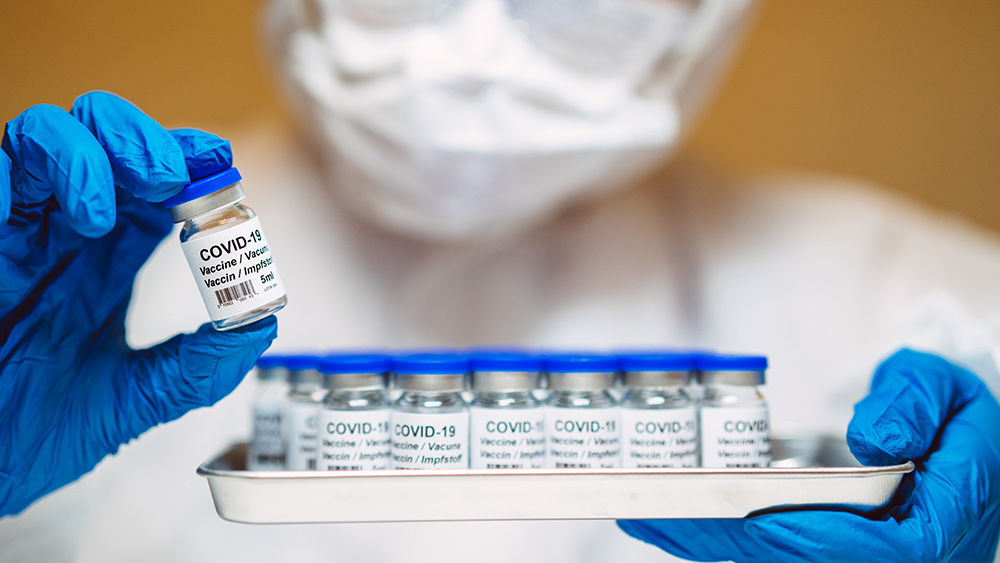 Parler
Parler Gab
Gab
- Texas reports 309 measles cases in early 2025—more than the entire U.S. in 2024—despite administering 15,000 additional MMR doses.
- CDC research confirms measles vaccine virus sheds in urine for up to 14 days post-vaccination, raising transmission risks.
- The MMR vaccine strain is a product of gain-of-function (GOF) research, engineered to infect more human cells than wild measles.
- Immune-compromised individuals may spread vaccine-derived measles, complicating outbreak containment.
Vaccine-induced shedding: a hidden driver of outbreaks?
As measles cases surge across Texas in early 2025, public health officials face an unsettling paradox: despite a statewide push to administer more measles-mumps-rubella (MMR) vaccines, the outbreak has already eclipsed the total number of U.S. cases reported in all of 2024. With 309 confirmed infections—up from just 285 nationwide last year—the spike follows a 15,000-dose increase in measles vaccinations. But buried in decades of scientific literature is a rarely discussed phenomenon: the measles vaccine itself can spread the virus. A 1995 CDC study published in the Journal of Clinical Microbiology detected measles virus RNA in the urine of 83% of vaccinated children for up to two weeks after receiving the MMR shot. The researchers, led by Paul A. Rota, noted that viral shedding began as early as one day post-vaccination and persisted in some cases for 14 days. Similar findings were replicated in a 2024 Journal of Clinical Virology study, which identified shedding for 29 days in recently immunized individuals. This raises a critical question: Could aggressive vaccination campaigns inadvertently amplify community transmission? "The vaccine virus is alive, replicating, and excreted," explains Dr. Suzanne Humphries, a nephrologist and vaccine researcher. "When you inject a live virus into a person, especially someone immunocompromised, that virus can escape into the environment."Gain-of-function engineering: a more invasive measles strain
Compounding the issue is the MMR vaccine’s design. A 2016 study in The Journal of Infectious Diseases revealed that the vaccine’s Edmonston strain was engineered through gain-of-function (GOF) techniques to bind CD46—a receptor found on nearly all human nucleated cells. Wild measles primarily targets CD150, a marker on immune cells. Original (Wild-Type) Measles Virus (Montefiore 89 Strain): The naturally occurring measles virus primarily infects immune cells by binding to the CD150 receptor. Lab-Modified (Vaccine) Strain (Edmonston Strain): In contrast, the vaccine strain has been altered in the lab to gain the ability to bind CD46—a receptor found on nearly all nucleated human cells and present in much higher abundance than CD150. Because of this engineered adaptation, the vaccine strain of measles virus has the potential to enter a broader range of cells compared to the wild-type virus, due to its expanded receptor usage. This manipulation means the vaccine virus can infect a broader range of tissues than its natural counterpart. Combined with prolonged shedding, the risk of vaccine-derived transmission escalates—particularly among the unvaccinated or those with weakened immunity.Texas: a case study in failed containment
Gaines County, Texas, saw a 242% spike in measles cases after a health district distributed free MMR vaccines in early 2024. Now, with statewide cases soaring, health officials admit the outbreak is likely under-counted and expected to worsen. Historical context sharpens the concern: 1966: Measles antigen was detected in vaccinated individuals’ urine for 16 days post-injection. 1995: CDC confirmed viral RNA shedding in children. 2024: Peer-reviewed studies extended the shedding window to 29 days. However, with vaccine shedding well known for decades, public health messaging continues to blame the unvaccinated, ignoring the vaccine’s own role in viral spread. With measles dominating headlines in 2025, the Texas outbreak forces a uncomfortable debate: Are we trading short-term "herd immunity" for long-term viral persistence? As vaccine-derived cases mount, the medical establishment faces a dilemma—one that echoes the early days of polio, where the vaccine itself seeded outbreaks. "When you vaccinate millions," warns biologist Dr. Stephanie Seneff, "you’re conducting an uncontrolled experiment on the whole population." Will health agencies finally confront the evidence—or will the cycle of outbreaks and boosters continue indefinitely? Sources include: Modernity.news NIH.gov [PDF] JonFleetwood.substack.com ScienceDirect.com Enoch, Brighteon.aiPumpkin juice RECALLED over potential botulism risk
By Ava Grace // Share
FBI imposed “gag order” after accidentally confirming Hunter Biden laptop was authentic
By Cassie B. // Share
COVID mRNA injections linked to genetic changes that increase brain tumor and leukemia risk
By Lance D Johnson // Share
“Forever chemicals” haunt North Carolina homes as PFAS found in dust near Chemours plant
By Cassie B. // Share
Governments continue to obscure COVID-19 vaccine data amid rising concerns over excess deaths
By patricklewis // Share
Tech giant Microsoft backs EXTINCTION with its support of carbon capture programs
By ramontomeydw // Share
Germany to resume arms exports to Israel despite repeated ceasefire violations
By isabelle // Share










